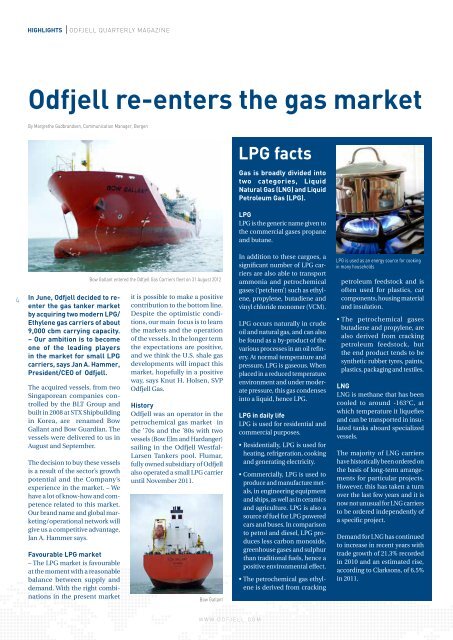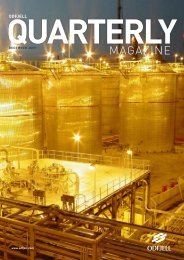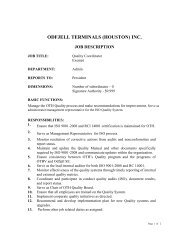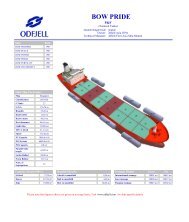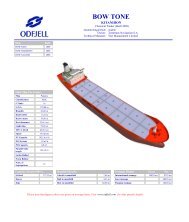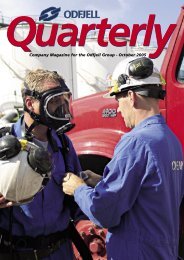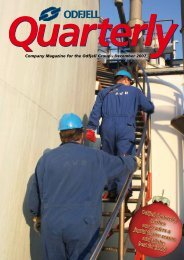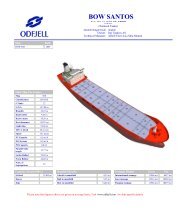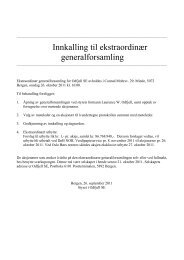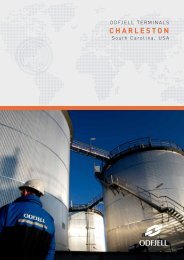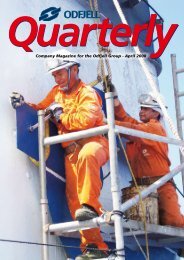Odfjell Quarterly October 2012
Odfjell Quarterly October 2012
Odfjell Quarterly October 2012
- No tags were found...
Create successful ePaper yourself
Turn your PDF publications into a flip-book with our unique Google optimized e-Paper software.
highlightsODFJELL QUARTERLY magazine<strong>Odfjell</strong> re-enters the gas marketBy Margrethe Gudbrandsen, Communication Manager, BergenLPG factsGas is broadly divided intotwo categories, LiquidNatural Gas (LNG) and LiquidPetroleum Gas (LPG).LPGLPG is the generic name given tothe commercial gases propaneand butane.4In June, <strong>Odfjell</strong> decided to reenterthe gas tanker marketby acquiring two modern LPG/Ethylene gas carriers of about9,000 cbm carrying capacity.– Our ambition is to becomeone of the leading playersin the market for small LPGcarriers, says Jan A. Hammer,President/CEO of <strong>Odfjell</strong>.The acquired vessels, from twoSingaporean companies controlledby the BLT Group andbuilt in 2008 at STX Shipbuildingin Korea, are renamed BowGallant and Bow Guardian. Thevessels were delivered to us inAugust and September.The decision to buy these vesselsis a result of the sector’s growthpotential and the Company’sexperience in the market. – Wehave a lot of know-how and competencerelated to this market.Our brand name and global marketing/operationalnetwork willgive us a competitive advantage,Jan A. Hammer says.Favourable LPG market– The LPG market is favourableat the moment with a reasonablebalance between supply anddemand. With the right combinationsin the present marketBow Gallant entered the <strong>Odfjell</strong> Gas Carriers fleet on 31 August <strong>2012</strong>it is possible to make a positivecontribution to the bottom line.Despite the optimistic conditions,our main focus is to learnthe markets and the operationof the vessels. In the longer termthe expectations are positive,and we think the U.S. shale gasdevelopments will impact thismarket, hopefully in a positiveway, says Knut H. Holsen, SVP<strong>Odfjell</strong> Gas.History<strong>Odfjell</strong> was an operator in thepetrochemical gas market inthe ’70s and the ’80s with twovessels (Bow Elm and Hardanger)sailing in the <strong>Odfjell</strong> Westfal-Larsen Tankers pool. Flumar,fully owned subsidiary of <strong>Odfjell</strong>also operated a small LPG carrieruntil November 2011.Bow GallantIn addition to these cargoes, asignificant number of LPG carriersare also able to transportammonia and petrochemicalgases (‘petchem’) such as ethylene,propylene, butadiene andvinyl chloride monomer (VCM).LPG occurs naturally in crudeoil and natural gas, and can alsobe found as a by-product of thevarious processes in an oil refinery.At normal temperature andpressure, LPG is gaseous. Whenplaced in a reduced temperatureenvironment and under moderatepressure, this gas condensesinto a liquid, hence LPG.LPG in daily lifeLPG is used for residential andcommercial purposes.• Residentially, LPG is used forheating, refrigeration, cookingand generating electricity.• Commercially, LPG is used toproduce and manufacture metals,in engineering equipmentand ships, as well as in ceramicsand agriculture. LPG is also asource of fuel for LPG poweredcars and buses. In comparisonto petrol and diesel, LPG producesless carbon monoxide,greenhouse gases and sulphurthan traditional fuels, hence apositive environmental effect.• The petrochemical gas ethyleneis derived from crackingLPG is used as an energy source for cookingin many householdspetroleum feedstock and isoften used for plastics, carcomponents, housing materialand insulation.• The petrochemical gasesbutadiene and propylene, arealso derived from crackingpetroleum feedstock, butthe end product tends to besynthetic rubber tyres, paints,plastics, packaging and textiles.LNGLNG is methane that has beencooled to around -163°C, atwhich temperature it liquefiesand can be transported in insulatedtanks aboard specializedvessels.The majority of LNG carriershave historically been ordered onthe basis of long-term arrangementsfor particular projects.However, this has taken a turnover the last few years and it isnow not unusual for LNG carriersto be ordered independently ofa specific project.Demand for LNG has continuedto increase in recent years withtrade growth of 21.3% recordedin 2010 and an estimated rise,according to Clarksons, of 6.5%in 2011.www.odfjell.com


